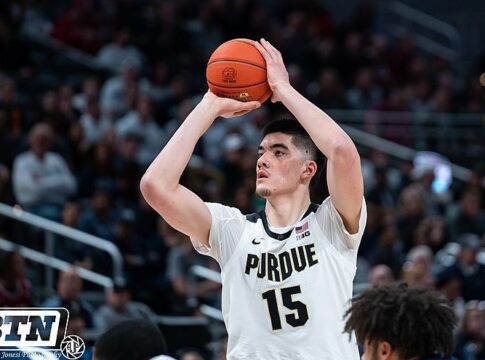By Julia Tong, AsAmNews Intern
Fill in the blanks: “Legend has it that (NUMBER) year ago, the Nian monster would rise from the sea.” “The wise and (ADJECTIVE) Jade Emperor.” “Dumplings are shaped like gold (PLURAL NOUN).”
These are snippets from Ellen Lee’s new Lunar New Year-themed Mad Libs book. A classic fill-in-the-blank children’s game, Mad Libs requires readers to first come up with a series of random words, such as adjectives, nouns, numbers, adverbs. Hilarity ensues after these words are placed into corresponding blanks in a story. Through Lee’s Mad Libs book, readers will be able to revisit traditional stories with a funny and interactive twist.
AsAmNews spoke to Lee about her journey to Mad Libs, Lunar New Year, and Asian American representation in the children’s publishing industry.
Lee’s journey into writing children’s literature had a very unconventional start: business and tech journalism. A graduate from Columbia University School of Journalism, Lee subsequently worked at the Contra Costa Times, before joining the staff of the San Francisco Chronicle. There, she covered the beginnings of present-day giants: Apple and the first iPhone, the origins of YouTube, Instagram, AirBnB, Pinterest, Uber. (“That’s how old I am,” she jokes with a laugh). In those days, Lee developed relationships with those companies so close she could message them at 11 p.m. and expect a response. (Full disclosure: Lee also volunteered as a senior editor of AsAmNews in 2021)
LATEST STORIES
However, when she had her first child around ten years ago, Lee quit the Chronicle and went freelance. Raising her children sparked a new interest for Lee: writing children’s literature, with a particular focus on nonfiction stories. This passion grew as she observed the poor representation of Asian Americans in children’s writing at the time.
“One of the reasons why I wanted to start writing for kids was because of my frustration at the time of going to the library into the bookstore, and seeing so few books about Asian Americans, and especially nonfiction,” Lee said. “[And] then to pick up certain books and see that they were written not by Asian American creators was also frustrating for me.”
Lee recalls a study done by the Cooperative Children’s Book Center (CCBC) in 2019, which examines representation in the children’s book industry. The study contains a graph titled “Percentage of Total Books Received at the CCBC with at Least One Primary Character from Specified Category.” The bars for the people of color, including “African,” “Native,” “Asian,” “Pacific” and “Brown Skin,” are squat, ranging from 0.05%-11.2%. But two bars dominate the graph: “White,” representing nearly half of all books, and “Animal/Other,” representing nearly a third.
As the CCBC notes, “books about White children, talking bears, trucks, monsters, potatoes, etc. represent nearly three-quarters (71%) of children’s and young adult books published in 2019.”
In Lee’s experience, the consequences of this marginalization were clear. Lee recalls being “madden[ed] and frustrat[ed]” by the older books she found by non-Asian writers and the “Orientalizing of Asian Americans”. Lee’s determination to write children’s literature was in part powered by a desire to see a better representation of Asian Americans in that space.
This opportunity presented itself when one of Lee’s connections introduced her to an editor from Mad Libs. The company’s holiday series, Lee observed, had already featured Kwanzaa and Diwali. Now, they were looking for a writer to write a Lunar New Year’s edition. The friend thought Lee would be a perfect fit.
Lee was intrigued by the idea of taking on a humor project— a far cry from the journalistic work she was used to. However, as she wrote her proposal, she wanted to ensure that the book would be respectful to Asian cultures.
“I want[ed] to make sure that it’s funny and not offensive,” she recalled. Thankfully, the Mad Libs staff felt the same: “The editor was completely on board with that because that’s something that they were very sensitive to.”
Lee’s proposal was ultimately accepted. Her Lunar New Year Mad Libs edition contains 21 stories that feature traditional tales and customs: the Nian monster, the Zodiac animals (“animals stories are always very popular” amongst kids, she notes), cleaning the house before the holiday, different celebrations across Asia. For Lee, who identifies as Chinese American, many of those stories drew from her own experiences.
“[The stories] all come from my personal life I grew up here celebrating Chinese New Year, every year with my family, and I’m very lucky I live close to my family still, so it’s something that we still get together and celebrate,” she says.
Many of those memories made it into the book: eating large meals with family, including a traditional fish dish that puns on the Chinese phrase for yearly abundance (年年有余); red envelopes to the kids; cleaning to sweep away bad luck. As a San Francisco native, too, Lee wanted to spotlight the city’s Lunar New Year parade, which is the largest outside of Asia.
However, Lee wanted to make sure to acknowledge the many different ways that Lunar New Year is celebrated around Asia, such as Seollal and Tet, the Korean and Vietnamese New Year respectively. In order to do so, Lee consulted friends from different Asian backgrounds and editors who are responsible for reading drafts for cultural accuracy (or, conversely, stereotypes)— to ensure the final book was inclusive. At times, these resulted in specific changes to the book’s contents.
In terms of future plans, Lee feels like she’s still at the beginning of her “journey in terms of kid lit.” Though she’s currently working on two more Mad Libs books, including Grandma Mad Libs, she is also hoping to branch out into other sectors of the children’s literature industry.
In the meantime, buoyed by the increase in the number of people of color being published, she remains an avid proponent of authentic, multifaceted, and accurate Asian representation in literature.
“I hope that we can also recognize other parts of Asian American and Asian culture and not just Lunar New Year,” she says. “But I think it’s also exciting to see people acknowledge the diversity within the United States and then the diversity within Asian Americans too.”
(Editor’s Note: AsAmNews receives a 10% commission if books are purchased from the link above)
AsAmNews has Asian America in its heart. We’re an all-volunteer effort of dedicated staff and interns. Check out our new Instagram account. Go to our Twitter feed and Facebook page for more content. Please consider interning, joining our staff, or submitting a story, or making a contribution.








